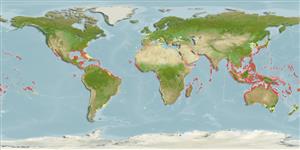Common names from other countries
Environment: milieu / climate zone / depth range / distribution range
Ecologia
marinhas; oceanódromo (Ref. 51243); intervalo de profundidade 0 - 20 m. Subtropical; 44°N - 36°S, 180°W - 180°E
Widespread in tropical and subtropical zones of all oceans including the western Mediterranean Sea and part of the Caribbean Sea (Ref. 3720), probably absent in the inland seas of southeastern Asia (Sulawesi Sea, Sulu Sea, Flores, Banda, Ceram and Halmahera seas (Ref. 27313)), and the Benguela Current (Ref. 4498). Eastern Pacific: Mexico to central Chile; also the Galapagos and Hawaii. Western Pacific: Japan, Marshall Islands, Philippines, Australia (Ref. 5530), and Tahiti.
Tamanho / Peso / Idade
Maturity: Lm ? range ? - ? cm
Max length : 30.0 cm TL macho/indeterminado; (Ref. 9987); common length : 20.0 cm TL macho/indeterminado; (Ref. 5217)
Espinhos dorsais (total) : 0; Raios dorsais moles (total) : 12 - 15; Espinhos anais: 0; Raios anais moles: 12 - 14; Vértebras: 43 - 46. Body dark, iridescent blue above, silvery white below; pectorals and caudal fin greyish, other fins not pigmented (Ref. 2797). Juveniles with or without black bars (Ref. 2797). Branchiostegal rays: 9-11 (Ref. 36606).
Adults occur in surface waters, both near and far from the coast (Ref. 5217). Form schools. Capable of leaping out of the water and gliding for long distances above the surface. Feed mostly on crustaceans and other planktonic animals. Preyed upon by swordfish, tunas and many other larger pelagic fishes (Ref. 9987). Oviparous, with planktonic eggs and larvae (Ref. 36606).
Parin, N.V., 1996. On the species composition of flying fishes (Exocoetidae) in the West-Central part of tropical Pacific. J. Ichthyol. 36(5):357-364. (Ref. 27313)
Categoria na Lista Vermelha da IUCN (Ref. 130435)
CITES (Ref. 128078)
Not Evaluated
Ameaça para o homem
Harmless
Utilização humana
Can't connect to MySQL database (fbapp). Errorcode: Too many connections
